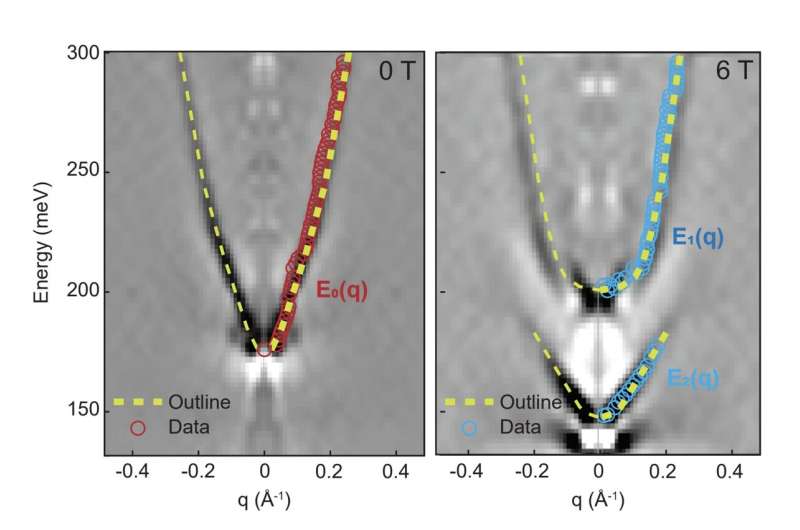May 17, 2024 feature
This article has been reviewed according to Science X's editorial process and policies. Editors have highlighted the following attributes while ensuring the content's credibility:
fact-checked
peer-reviewed publication
trusted source
proofread
The observation of a Spin Berry curvature-enhanced orbital Zeeman effect in a kagome metal

In solid materials, magnetism generally originates from the alignment of electron spins. For instance, in the ferromagnet iron, the overall net magnetization is prompted by the alignment of spins in the same direction.
In recent years, physicists and material scientists have identified materials in which magnetism arises differently, due to topological factors. Many studies have since been aimed at discovering new materials that exhibit these unconventional forms of magnetism.
Researchers at Boston College, University of California Santa Barbara, University of Wurzburg and other institutes recently observed magnetism of topological origin in a bilayer kagome metal, namely TbV6Sn6. Their paper, published in Nature Physics, uncovered a colossal orbital Zeeman effect enhanced by Spin Berry curvature in TbV6Sn6.
"In some new materials, magnetism can arise in other ways, for example from the topology of electronic bands," Ilija Zeljkovic, co-author of the paper, told Phys.org.
"Some electronic states can acquire a property called Berry curvature, which can in turn lead to orbital magnetic moments associated with particular electronic states. Interestingly, such orbital magnetic moments can be enormous, much larger than that of an individual spin."
The key objective of the recent study by Zeljkovic and his colleagues was to probe the special orbital moments reported in previous works, specifically in the kagome material TbV6Sn6. In addition, they hoped to better understand how these moments responded to magnetic fields.
"Kagome materials in general have been proposed to exhibit these due to the geometry of the lattice that can naturally give rise to topological dispersionless flat bands and Dirac points, special points where linearly dispersing bands cross," Zeljkovic said. "Berry curvature and spin-Berry curvature tend to be substantial near Dirac points if the Dirac point is gapped, which leads to large orbital magnetic moments and facilitates their observation."
The researchers examined their TbV6Sn6 sample using a technique known as scanning tunneling microscopy and spectroscopy (STM/S). This technique entails using a sharp metallic tip placed close to the sample's surface (i.e., within a few Angstroms) to measure the tunneling current as a function of the tip's position.
"The tunneling current contains information on the electronic density-of-states (DOS), or how many electronic states do we have available at any given energy for the electrons to occupy," Zeljkovic explained. "We performed spatial spectroscopic mapping of the DOS using STM to map electronic states as a function of energy and momentum."
Zeljkovic and his colleagues subsequently repeated the same experiment focusing on magnetic fields, with the aim of uncovering the evolution of these electronic states in magnetic fields. This second experiment ultimately allowed them to extract the orbital magnetic moments associated with individual electronic states.
"We found that orbital magnetic moments near the Dirac point are hundreds of times larger than those of the magnetic moment associated with electron spin," Zeljkovic said. "We also visualized how the degenerate electronic states with opposite Spin Berry curvature deform in magnetic fields in opposite directions, a phenomenon we refer to as orbital Zeeman splitting."
The researchers observed that the splitting of the electron band degeneracy in their sample was surprisingly large, and its size was rooted in its large underlying spin-Berry curvature. Their experimental results were later corroborated by a series of theoretical calculations.
The recent work by this team of researchers gathered interesting insight into unconventional magnetic states of a topological origin. In the future, their findings could inspire further research efforts investigating other large orbital magnetic moments driven by the Berry curvature, such as those previously observed in some graphene-based structures.
"In the material we examined, large orbital magnetic moments are associated with states away from the Fermi level," Zeljkovic added. "If one can tune the material so that these electronic states can emerge near Fermi level, by for example strain or chemical doping, these moments can potentially give rise to orbital magnetism that can be detected by other experimental probes too, and potentially useful for down-the-line applications in devices."
More information: Hong Li et al, Spin Berry curvature-enhanced orbital Zeeman effect in a kagome metal, Nature Physics (2024). DOI: 10.1038/s41567-024-02487-z.
Journal information: Nature Physics
© 2024 Science X Network





















